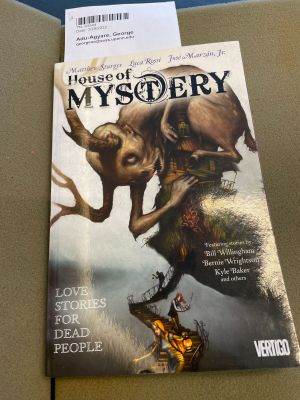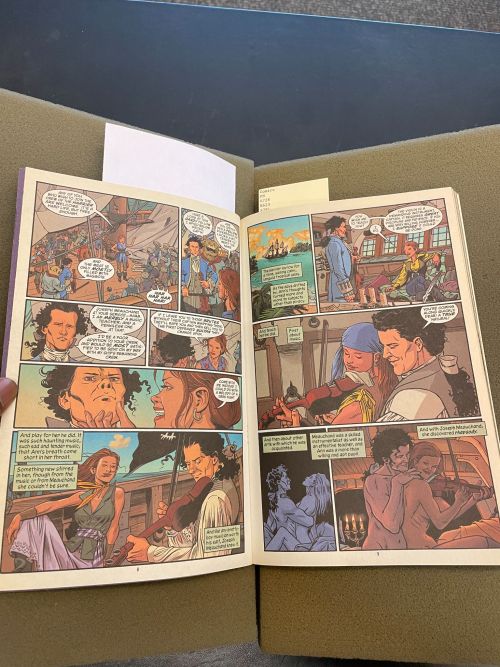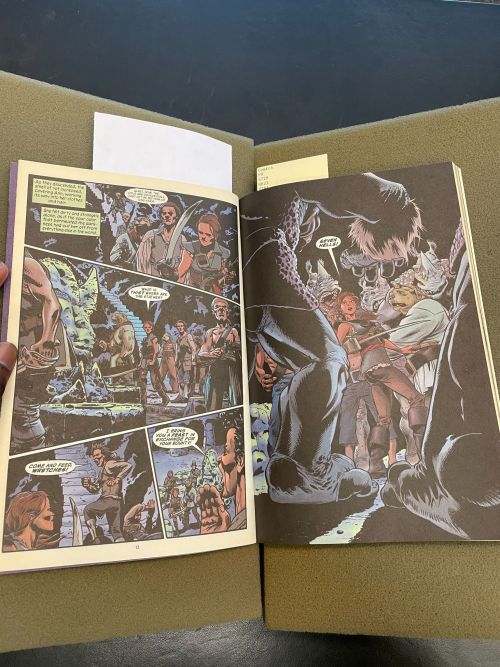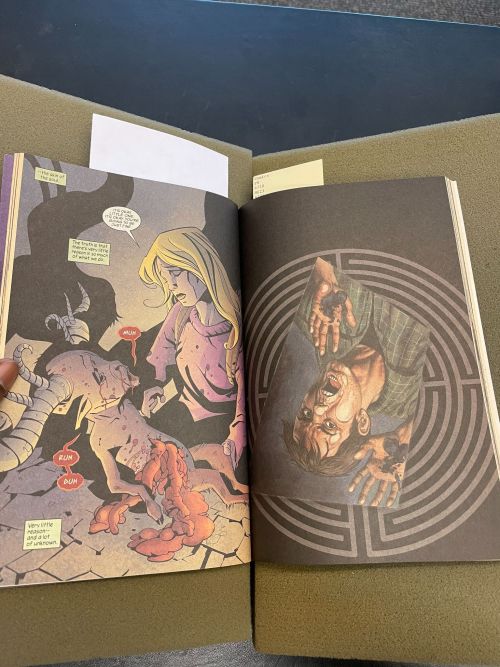House of Mystery, Volume 2: Love Stories for Dead People

House of Mystery, Volume 2: Love Stories for Dead People is an American horror-themed comic book, part of the House of Mystery series, primarily written by the Rhode Island native Lilah Sturges, with the series spanning from 2008-2011.
Background
Introduction to the Historical Analysis and Implications of the Book
There is a need to situate this discussion of the book historically, as it bears significance to having a deeper understanding of the book. Important questions are: (1) what significance does our book have for its historical moment, for the history of the book, for the history of authorship or copyright? (2) What does the item’s substrates or formats tell us about how it was made or used? (3) How did this book circulate, and who would have read it? And (4) does it offer any evidence of readership? Relevant context is needed to address the questions. In order to discuss the first question, discussion of the general history of the book— including the history of the publisher and author— is required. To address the second question, discussion of the material and physical properties of the book itself is also crucial. The contextual information provided will reveal answers to the questions of importance.
Pertinent History that is Relevant to the Historical Analysis and Implications of the Book
History of the Series
House of Mystery is a series of comics; the original House of Mystery series was published in 1951 as a series of horror / occult themed comics including supernatural elements like werewolves and vampires. The culture of the 1950s viewed these comics to be overly taboo; thus, in order to survive, the series revamped itself as a science fiction comic with elements such as monsters and suspenseful mysteries. The series ran its natural course and finished in 1983 with issue #321— the number of issues of a comic book are similar to the number of episodes of a TV show. There was an attempt to revive or re-continue the series between 1986 and 1987, but it wasn’t quite successful. The current series that this book falls under is the latest revival series from 2008. Now that the culture has changed drastically, the author and publisher felt it was okay to make this series more horror and occult themed (ultimately undoing the creative restrictions imposed by the culture of the 1950s). The series concluded in 2011 with issue #42.
History of the Publisher
The publisher of this book is Vertigo Comics or just Vertigo. Vertigo Comics, whose parent company is DC Comics, was established in 1993 with the sole purpose of publishing things that didn’t fit in-line with DC's main publications. Things such as excessive profanity, drug use, nudity, violence, etc. Due to the nature of Vertigo’s publications, their editors had more creative freedom. Given the history of the series provided, and given the brief history of the publisher just provided, it makes sense that Vertigo was the most appropriate publisher for this book. In January of 2020, DC decided to discontinue Vertigo and rebrand the publisher as DC Black Label (readership of ages 17 and up).
History of the Author
Lilah Sturges, formerly known as Matthew Sturges, has been a writer her whole life. She specializes in fantasy, science fiction, horror, comedy, and mystery comics— which all fall in line with the genre of this book. She signed a contract with DC in 2006 and shortly after began writing for Vertigo.
Having discussed the general history of the book, transitioning to the material and physical properties of the book itself will follow.
The Book as an Object
Material and Physical Properties of the Book
These are the following questions which are pertinent in this section: (1) How was it printed? (2) Does it have color or is it printed in black and white? (3) Are the blocks on each page standard templates, or do they change every time? The printing method applied to this book is called offset lithography.
Research [1] reveals the following: aluminum metal plates on a conveyor flow through a playwright machine where images are etched onto [1]; the aluminum plates are then attached to the rollers of a printing press [1], and paper stock is fed into the press which travel through the rollers where images from the aluminum plates are copied on [1]; the paper is then cut into pages, and the pages are sent through a machine which folds and aligns them in the correct order [1]; the folded pages are sent through a binding machine that creates the final product [1].
This book is printed in color, and while it was printed using templates, the image / text layout on each page is variable; this is likely due to the fact that different images can be etched on various templates of the same type [1] [2] [3]. The specific type of paper used is either #60 or #70 matte paper, which is common for most comic books [1]. This type of paper is thicker than the standard printer paper used in writing and is popular because images reflect nicely on them [2] [3]. Please see below a page sample of the book, where the colors used can be observed, variation in image / text layout can be observed, and the quality of paper used can be observed.

There are many interesting points about the text features. As this book is a comic, it does not have a table of contents, an index, or a glossary [1]. Typically, comic books don’t need a table of contents because they are printed in issues or volumes— each issue of a comic is essentially a chapter in the broader narrative of a collection [3]. Indices and glossaries are also not needed because the words used are very simple and the setting of most comics are fictional [2]. However, because it is a comic, there are an abundance of bold words, illustrations, and labels. In the picture below, observe how some words on the bottom row of the left page and the right page are bolded for effect; observe the general illustration and labeling as well.

Given a proper introduction to the history of the series, history of the publisher, history of the author, and a discussion of the material and physical properties of the book itself, a conduction of the historical analysis and implications of the book will follow.
Historical Analysis and Implications of the Book
Significance of the Book for its Historical Moment, for the History of the Book, for the History of Authorship or Copyright
The second part of this headline has already been addressed. Information from the history above is relevant for discussing the rest of the headline, i.e.— the significance of the book for its historical moment, and for the history of authorship or copyright.
Based on the historical context provided about the book, it implies that in its current historical moment, the book signifies a shift in cultural beliefs and norms [4]. In order for the original series to survive, the authors and publishers had to change the scope of the book to conform to the “pure” and conservatively minded conventions of the 1950s. Today, things are clearly different. In modern times, there is more leniency— and even acceptance— of elements previously thought to be taboo in every manner [4]. The shift in ideals of these elements include: increased acceptance of secularism [4] and its consequences, i.e., freedom of artistic expression in adultery, drugs, violence, profanity, the occult, pride, anger, sadness, greed, lust, and agnosticism [4] (to name a few).
This is also relevant to the history of authorship or copyright [4] as well because— as it is known— as the culture of the United States kept evolving, publishers (such as Vertigo) and authors were allowed more freedom in their artwork; they needn’t worry about the possibility of sanctions for their controversial views [4] (unless their views are racist, homophobic, sexist, ableist, or anything that can get an individual canceled in today’s culture of course).
What the Context Around the Book’s Substrates or Formats Reveal How it Was Made or Used
The discussion of how the book was made can be found in the Material and Physical Properties of the Book section of this wiki. Rather, it's productive to discuss how the book was used. In literary works, or hybrid literary works, comic books have the competitive advantage in using visual rhetoric to convey information [2] [3]. Consider the feature of the speech bubble. These bubbles are fundamental to the form of a comic book for many reasons. (1) They help display the speaker’s identity and emotional state [2] [3], and (2) the reader always knows the private inner thoughts and public expressions of characters [2] [3]. Consider this example which was covered in the Material and Physical Properties of the Book section of this wiki: if a character is shouting, certain words will be bolded or fully capitalized [2] [3]. To provide another example on the representation of a character’s emotional state, if a character is angry / sad / in a vulnerable emotional state, the bubble might be misshapen [2] [3]. See below for an illustration of this. The magenta-colored alien is dying and therefore his speech bubbles are irregularly shaped to emphasize the pain the alien is experiencing.

Illustrations are also fundamental to the form of a comic book [2] [3]. Visuals leave very little room for confusion because there exists a literal picture of what is going on. Elements which are presented in graphics, such as gestures and facial expressions, are critical to characterization [2] [3]. Furthermore, color hues dictate the tone and mood of the comic narrative [3].
Lastly, in terms of how the book is used, it is useful to think about why this book is stored in the University of Pennsylvania's Kislak Center for Special Collections, Rare Books and Manuscripts located on the sixth floor of the Van Pelt Library. Comic books are considered rare based on factors like age and issue number. Typically, the older the “better”, and the less issues the “better”. This series of comics has 42 issues, and for comparison, the original Batman and Superman comics from the late 1930s had 15,000 and 18,000 issues respectively. Thus this series of comics has a low number of issues (despite a young age), making it rare.
How the Book Circulated, Readership of the Book
As most people can relate to from their childhood experiences, comic books— along with other graphic arts— are circulated in places like: the comic book store, the grocery store, libraries, retail stores in general, etc. Readership [4] for this specific type of comic book are fans of horror comics, mystery comics, and science fiction comics. Age can vary, as there are a lot of young readers [4] in the field of comics, and there are also veteran readers who have been reading such genres since their adolescence [4].
References
Works Cited
- ↑ 1.0 1.1 1.2 1.3 1.4 1.5 1.6 1.7 1.8 Simon, Mark. Create a Comic Book Using Existing Art in Clip Studio Paint/ with Mark Simon. Carpenteria, CA: linkedin.com, 2021.
- ↑ 2.0 2.1 2.2 2.3 2.4 2.5 2.6 2.7 2.8 2.9 Groensteen, Thierry. System of Comics. Jackson: University Press of Mississippi, 2007.
- ↑ 3.00 3.01 3.02 3.03 3.04 3.05 3.06 3.07 3.08 3.09 3.10 Mikkonen, Kai. The narratology of comic art / Kai Mikkonen. New York : Routledge, 2017.
- ↑ 4.0 4.1 4.2 4.3 4.4 4.5 4.6 4.7 4.8 Pustz, Matthew. Comic books and American cultural history : an anthology / [edited by] Matthew Pustz. London ; New York: Continuum, 2012.